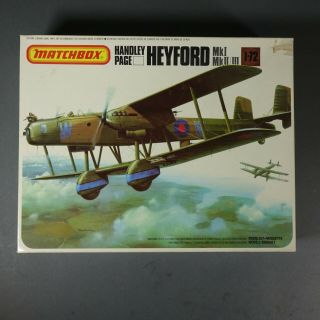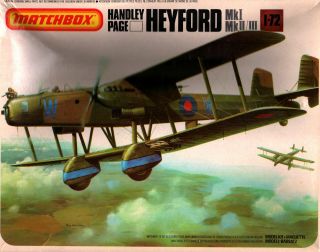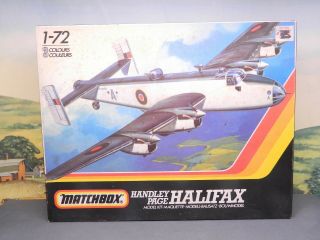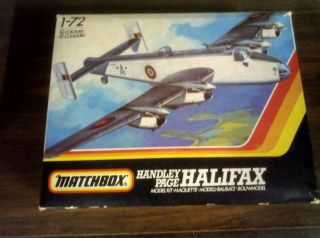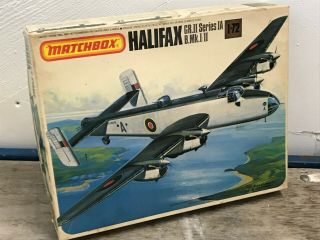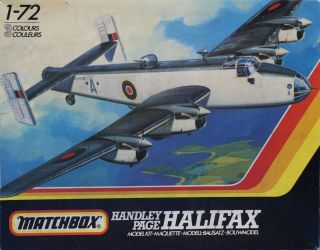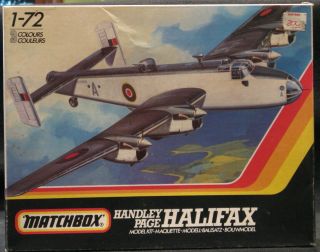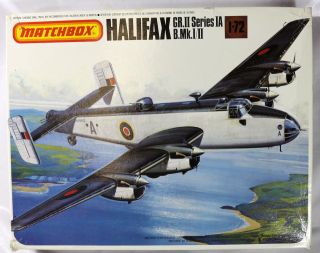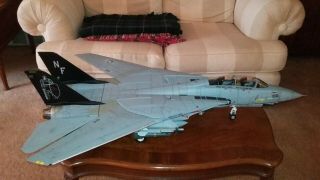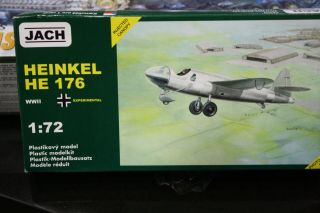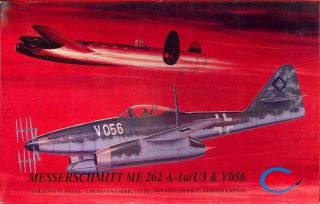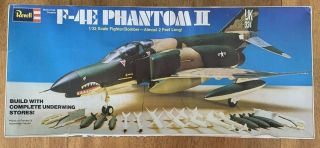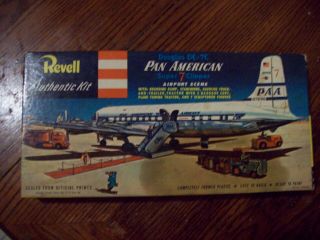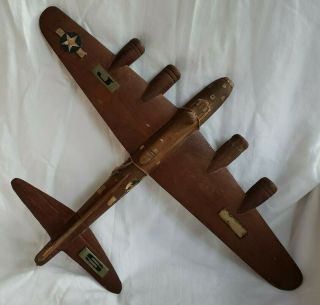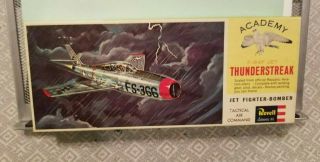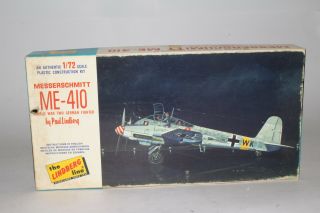MATCHBOX 1/72 HANDLEY PAGE HALIFAX WW2 RAF BOMBER Kit No. PK - 604 GR. IA Series IA
Item History & Price
| Reference Number: Avaluer:60601442 |
MATCHBOX1/72 HANDLEY PAGE HALIFAX WW2 RAF BOMBER Kit No.PK-604 GR.IA Series IA B.Mk.I/IIOPEN BOX UNBUILT PLASTIC MODELKIT – INVENTORIED 100% COMPLETEIF YOU HAVE ANY QUESTIONS ORCONCERNS PLEASE ASK ME BEFORE BIDDING / PURCHASING – I WANT EVERYONE TO BE 100%SATISFIED WITH NO SURPRISES OR MIS-UNDERSTANDINGS------------------------------------...--------Additional Information fromInternet EncyclopediaThe Handley Page Halifax, along with the AvroLancaster and the Short Stirling, was one of the three heavy bombers employedby The Royal Air Force Bomber Command in its aerial offensive against the Axisin W.W.II.Although overshadowed by the legendary Lancaster, the Halifax played a major role in the night bombing campaign, in antisubmarineoperations, meteorological reconnaissance, transport, and towing gliders inairborne operations.In all, over 6, 000 Halifax aircraft were producedand these were flown in over 75, 000 missions. It served from 1941 until finallyretired in 1952. At one time during their service in the RAF Bomber Command all15 RCAF Bomber Sqns and three Heavy Conv Units were equip’d with the Halifax, several operating only the Halifax.Although some Sqns began reequipping with theLancaster beginning in late 1943, the Halifax was the mainstay of these Sqnsfrom 1942 to the end of the war in night bombing and mine laying operations.This book documents the development of the Halifax aircraft from its inceptionduring the expansion of the RAF Bomber Command in the late 1930s untilproduction ended in 1946.Its service with RCAF 6 Group of Bomber Command, and its operations with all 15 RCAF Sqns is related, with representativephotographs. A complete description of each version of the aircraft ispresented, along with accurate multi-view line drawings and photographs.The aircraft defensive and offensive armament is describedas well as color schemes and markings. Finally, a chapter is dedicated tomodeling the Halifax with descriptions of kits and decal markings that havebeen produced.This book will be a worthy addition to thecollection of the historian, to the modeler and for those who served in theHalifax Sqns or their families.The Handley PageHalifax was one of the four-engined heavy bombers of the Royal Air Force duringthe Second World War. A contemporary of the famous Avro Lancaster, the Halifaxremained in service until the end of the war, performing a variety of duties inaddition to bombing. The Halifax was also operated by Sqns of the RoyalCanadian Air Force, Royal Australian Air Force, Free French Air Force, andPolish forces, and after the Second World War by the Royal Egyptian Air Force, the Armée de l'Air and the Royal Pakistan Air Force.The introductionof the successful P.13/36 candidates was delayed by the necessity of orderingmore Armstrong-Whitworth Whitley and Vickers Wellington bombers first. Forquicker delivery Avro and HP.56 designs were ordered "off the drawingboard" in mid-1937. At the end of July, Handley Page was told to redesignthe HP.56 for four engines rather than two, as the Vulture was alreadysuffering technical problems. The Avro Manchester was built with Vultures andentered RAF service, but also suffered from engine problems.The redesignincreased the span from 88 ft (27 m) to 99 ft (30 m) and put on 13, 000 pounds(5, 900 kg) of weight. Four Merlins were specified by the Ministry in September1937. The mockup was assessed at the end of the year and construction of thetwo prototypes of the HP 57 began in March 1938. Modificationsresulted in the definitive H.P.57, which upon acceptance was given the servicename Halifax, following the practice of naming heavy bombers after major towns– in this case, Halifax in the West Riding of Yorkshire. The H.P.57 wasenlarged and powered by four 1, 280 hp (950 kW) Rolls-Royce Merlin X engines.Such was the promise of the new model that the RAF had placed their first orderfor 100 Mk.I Halifaxes "off the drawing board" in January 1938 withserials already assigned to HP.56 switched to HP.57. The maiden flight of theHalifax took place on 25 October 1939 from RAF Bicester, not long after Britaindeclared war on Germany.Halifax productionsubsequently began at Handley Page's (now English Electric) site in Samlesbury, Lancashire, with over 2, 000 bombers being built by this factory during the war.The Mk.I had a 22ft (6.7 m) long bomb bay as well as six bomb cells in the wings, enabling it tocarry 13, 000 lb (5, 900 kg) of bombs. Defensive armament consisted of two .303in (7.7 mm) Browning machine guns in a Boulton Paul Type C nose turret, with anadditional four in a Boulton Paul Type E tail turret, and, in some aircraft, two .303 in (7.7 mm) Vickers K machine guns in beam (side, or "waist")positions. The Merlins drove constant speed wooden-bladed Rotol propellers.Subtle modifications distinguished the Mk I aircraft. Aircraft of the firstbatch of fifty Mk I Halifaxes were designated Mk I Series I.These werefollowed by 25 of the Mk I Series II with increased gross weight (from 58, 000lb/26, 310 kg to 60, 000 lb/27, 220 kg) but with maximum landing weight unchangedat 50, 000 lb (23, 000 kg). The Mk I Series III had increased fuel capacity(1, 882 gal/8, 556 L), and larger oil coolers to accept the Merlin XX. A two-gunBP Type C turret mounted dorsally replaced the beam gunsIntroduction of1, 390 hp (1, 040 kW) Merlin XX engines and a twin .303 in (7.7 mm) dorsal turretinstead of waist guns resulted in the B Mk II Series I Halifax. The Mk IISeries I (Special) achieved improved performance by removing the nose anddorsal turrets. The Mk II Series IA had a moulded Perspex nose (the standardfor future Halifax variants), a four-gun Defiant-type dorsal turret, Merlin 22engines and larger, trapezoidal-shaped vertical tail surfaces which solvedcontrol deficiencies from fin-stall with the roughly triangular-shape originalsurfaces, leading to rudder overbalance in the early marks. Halifax IIs werebuilt by English Electric and Handley Page; 200 and 100 aircraft respectively.Owing to ashortage in Messier-built landing gear and hydraulics, Dowty landing gear wasused. As it was incompatible with the Messier equipment this gave Halifaxeswith new desig’ds: a Mark II built with Dowty gear was the Mark V. The use ofcastings rather than forgings in the Dowty undercarriage speeded production butresulted in a reduced landing weight of 40, 000 lb (18, 000 kg). The Mark V werebuilt by Rootes Group at Speke and Fairey at Stockport and were generally usedby Coastal Command and for training. Some 904 had been built when Mark Vproduction ended at the start of 1944, compared to 1, 966 Mk II.The most numerousHalifax variant was the B Mk III of which 2, 091 were built. First appearing in1943, the Mk III featured the Perspex nose and modified tail of the Mk IISeries IA but replaced the Merlin with the more powerful 1, 650 hp (1, 230 kW)Bristol Hercules XVI radial engine. Other changes included de HavillandHydromatic propellers and rounded wing tips. The Mk IV was a non-productiondesign using a turbocharged Hercules powerplant.The definitiveversion of the Halifax was the B Mk VI, powered by the 1, 800 hp (1, 300 kW)Hercules 100. The final bomber version, the Mk VII, reverted to the lesspowerful Hercules XVI. However, these variants were produced in relativelysmall quantities.The remainingvariants were the C Mk VIII unarmed transport (8, 000 lb/3, 630 kg cargo pannierinstead of a bomb bay, space for 11 passengers) and the Mk A IX paratrooptransport (space for 16 paratroopers and gear). A transport/cargo version ofthe Halifax was also produced, known as the Handley Page Halton.The bomb aimer'sposition was in the extreme nose with the navigator's table behind it, bothposts being fulfilled by the same crew member. Above the navigator was theforward gun turret. The wireless (radio) operator was behind the navigator'sposition, separated by a half width partition. The pilot (left side) andco-pilot (right side) (the flight engineer filled in as a co-pilot, seated on afolding seat, during crucial manoeuvres such as take-off) occupied the cockpit, above the wireless operator. Aft of the pilots and on the same level as thenavigator and wireless operator was the flight engineer's compartment. Afurther compartment aft of the flight engineer contained two bunks originallyintended for resting crew members, but almost always used for treating andberthing injured crew. This area led to the two-gun dorsal turret. The tailgunner occupied a four-gun turret at the extreme aft end of the aircraft. In the Mk IISeries IA and from the Mk III onward, there was no longer a nose turret. Thebomb aimer occupied a streamlined perspex nose, with a single hand-held machinegun. The two-gun dorsal turret was replaced by a four-gun Boulton Paul turret.The maximum bombload was 14, 500 lb (6, 600 kg), carried in a bomb bay in the fuselage with sixseparate bomb compartments, and three bomb compartments in each wing inboardsection. This division of bomb bays and compartments limited the maximum sizeof bomb which could be carried to 2, 000 lb (910 kg).Halifaxes wereassembled from prebuilt sub assemblies. The surface panels were flush rivetedalthough the application of the matte black night bomber camouflage probablynegated the benefit. Total Halifaxproduction was 6, 178 with the last aircraft delivered in April 1945. Inaddition to Handley Page, Halifaxes were built by English Electric, FaireyAviation, and Rootes Motors (Rootes Securities Ltd) in Lancashire and by theLondon Aircraft Production Group. At peak one Halifax was completed every hour.The Halifaxentered service with No. 35 Sqn RAF at RAF Linton-on-Ouse in November 1940; itsfirst operational raid was against Le Havre on the night of 11–12 March 1941.Air Chief MarshalArthur Harris, head of Bomber Command, was scathing in his criticism of theHalifax's performance compared to the new Avro Lancaster, primarily of itsbomb-carrying capability: it was calculated that an average Halifax would drop100 tons of bombs in its lifetime compared to a Lancaster's 154. The fact thatlater Hercules-engined Halifaxes had lower loss rates and higher crew survivalrates after abandoning the aircraft than Lancasters, and came very close to itsspeed and altitude performance, did not alter his opinion. Also, unlike theLancaster, the Halifax's bomb bay could not be effectively adapted to carry the4, 000 pound "Cookie" blast bomb which was an integral part ofHarris's fire-bombing tactics. It was progressively outnumbered in frontlineservice over occupied Europe as more Lancasters became available from 1943onwards, with many Sqns converting to the Lancaster. Halifaxes continued to bebuilt because it was considered more efficient to allow existing manufacturingfacilities to continue producing them at a by-now efficient rate rather thanstop production for an unknown period while they converted to the Lancaster, while new manufacturing facilities were devoted to the Lancaster. Halifaxbombers were progressively relegated to secondary theatres such as North Africaand Italy, while many were converted to or built new as glider tugs, transportsand maritime reconnaissance.In service withRAF Bomber Command, Halifaxes flew 82, 773 operations and dropped 224, 207 tonsof bombs. 1, 833 aircraft were lost. In addition to bombing missions, theHalifax served as a glider tug, electronic warfare aircraft for No. 100 GroupRAF and special operations such as parachuting agents and arms into occupiedEurope. Halifaxes were also operated by RAF Coastal Command for anti submarinewarfare, reconnaissance and meteorological roles.After the warHalifaxes remained in service with Coastal Command and RAF Transport Command.Halifax B.I SeriesI: Four-engined long-range heavy-bomberaircraft; the first production version. Armament consisted of nose turret withtwo guns, tail turret with four guns and two beam gunsHalifax B.I SeriesII: Stressed for operating at a higher gross weight.Halifax B.I SeriesIII: Re-engined with Merlin XX engines, introduced new upper turret in place ofbeam guns, with revised undercarriage and additional centre-section fuel tanks.Halifax Mk II: Newvariant with increased takeoff weight, fuel and weapons carriage.Halifax B.IISeries I: First series of the bomber variant; from March 1942 onwards, thesewere fitted with TR1335 navigation aids.Halifax B.IISeries I (Special), SOE: Special version for Special Operations Executive (SOE)used to drop supplies over Europe. Nose armament and dorsal turret removed, thenose being faired over, as well as changes to the fuel vent pipes and exhaustshrouds.Halifax B.IISeries I (Special): Generally similar to the aircraft used by the SOE, thesewere employed in the bombing role. These aircraft were more varied inappearance, especially concerning the fitting of dorsal armament with someaircraft retaining the standard Boulton Paul "Type C" turret indifferent mounts with others mounting a "Type A" turret. There werealso examples with no dorsal turret, similar to the SOE-aircraft.Halifax B.IISeries IA: Modified with new glazed nose section, new radiators and new"D" fin and rudder. The dorsal turret was changed to a four-gunBoulton Paul Type A Mk VIII, and there were improvements to the bomb bay doorsealing. Some aircraft were fitted with the H2S radar.Halifax B.IISeries I, Freighter: A few Mk IIs were employed in the transport role in GreatBritain (unmodified SOE-aircraft) and in the Middle East (simple modificationsto allow carriage of engines or Spitfire fuselages).Halifax B.IISeries II: Single aircraft (HR756) modified with three-blade Rotol propellersand Merlin 22 engines. Rejected in favour of Mk III.Halifax GR.II:Coastal Command variant of the Halifax B.II.Halifax GR.IISeries I: A handful of aircraft converted from Series I or Special to GR.IIstandard, having differences in dorsal armament. The main difference was thefitting of a ASV.Mk 3 radar in an H2S type fairing. Sometimes, a .50 in (12.7mm) machine gun was fitted in the faired nose.Halifax GR.II SeriesIA: Definitive Coastal Command variant of the GR.II with glazed nose mounting.50 in (12.7 mm) machine gun, Merlin XX or 22 engines, B-P A-type dorsal turretand extra long-range fuel tanks in fuselage. A ventral turret holding a single.50 in (12.7 mm) machine gun was mounted on most aircraft although someemployed the ASV.Mk 3 radar in its place.Halifax B.III:Main production variant, fitted with Bristol Hercules engines. B.III bomberswere fitted with transparent nose dome with single machine gun, Boulton Pauldorsal turret with four guns and tail turret with four guns. Some B.IIIs hadextended round wingtips.Halifax A.III:Halifax B.III bombers converted into glider tug and paratroop transportaircraft.Halifax C.III:Halifax B.III bombers converted into military transport aircraft.Halifax B.V:Four-engined long-range heavy-bomber, powered by four Rolls-Royce Merlin XXengines with square empennage and wingtips. Armament as B.IIIHalifax B.V SeriesI (Special)Halifax A.V:Halifax B.V bombers converted into glider tugs and paratroop transportaircraft.Halifax GR.V:Coastal Command variant. Halifax B.V bombers converted into maritimereconnaissance aircraft.Halifax B.VI:Four-engined long-range heavy-bomber, powered by four 1, 615 hp (1, 204 kW) BristolHercules XVI radial engines with H2S radar. No dorsal turret. Square empennage, round wing tips.Halifax C.VI:Halifax B.VI bombers converted into military transport aircraft.Halifax GR.VI:Coastal Command variant. Halifax B.VI bombers converted into maritimereconnaissance aircraft.Halifax B.VII:Four-engined long-range heavy-bomber, powered by four 1, 615 hp (1, 204 kW)Bristol Hercules XVI radial engines. Round wing tips. Armament as B.IIIHalifax A.VII:Halifax B.VIIs converted into paratroop transport and glider tug aircraft.Halifax C.VII:Halifax B.VIIs bombers converted into military transport aircraft.Halifax C.VIII:Cargo and passenger transport aircraft.Halifax A.IX:Paratroop transport, glider tug aircraft.Halton I: Interimcivil transport version; postwar, a number of Halifax bombers were convertedinto civilian transport aircraft.Halton II: VIPtransport aircraft for the Maharajah Gaekwar of Baroda.Operators: RoyalCanadian Air Force (No. 405 Sqn RCAF, No. 408 Sqn RCAF, No. 415 Sqn RCAF, No.419 Sqn RCAF, No. 420 Sqn RCAF, No. 424 Sqn RCAF, No. 425 Sqn RCAF, No. 426 SqnRCAF, No. 427 Sqn RCAF, No. 428 Sqn RCAF, No. 429 Sqn RCAF, No. 431 Sqn RCAF, No. 432 Sqn RCAF, No. 433 Sqn RCAF, No. 434 Sqn RCAF)------------------------------------------------------------------------------------------Royal AustralianAir Force (No. 460 Sqn RAAF, No. 462 Sqn RAAF, No. 466 Sqn RAAF); Free FrenchAir Force (No. 346 Sqn RAF GB II/23 Guyenne, No. 347 Sqn RAF GB I/25 Tunisie);Pakistan Air Force (No. 12 Sqn); Polish Air Forces in exile in Great Britain(No. 301 Polish Bomber Sqn, C Flight No. 138 Sqn RAF later No. 1586 (PolishSpecial Duties) Flight before reforming as 301 Sqn Special Duties, No. 304Polish Bomber Sqn RAF); Royal Air Force (No. 10 Sqn RAF, No. 35 Sqn RAF, No. 47Sqn RAF, No. 51 Sqn RAF, No. 58 Sqn RAF, No. 76 Sqn RAF, No. 77 Sqn RAF, No. 78Sqn RAF, No. 96 Sqn RAF, No. 102 Sqn RAF, No. 103 Sqn RAF, No. 108 Sqn RAF, No.113 Sqn RAF, No. 138 Sqn RAF, No. 148 Sqn RAF, No. 158 Sqn RAF, No. 161 SqnRAF, No. 171 Sqn RAF, No. 178 Sqn RAF, No. 187 Sqn RAF, No. 190 Sqn RAF, No.192 Sqn RAF, No. 199 Sqn RAF, No. 202 Sqn RAF, No. 224 Sqn RAF, No. 246 SqnRAF, No. 295 Sqn RAF, No. 296 Sqn RAF, No. 297 Sqn RAF, No. 298 Sqn RAF, No.502 Sqn RAF, No. 517 Sqn RAF, No. 518 Sqn RAF, No. 519 Sqn RAF, No. 520 SqnRAF, No. 521 Sqn RAF, No. 578 Sqn RAF, No. 614 Sqn RAF, No. 620 Sqn RAF, No.624 Sqn RAF, No. 640 Sqn RAF, No. 644 Sqn RAF
Shipping & HandlingBack to Top US ShippingPlease check eBay's Shipping & Payment tab
USPS Priority Mail®
International ShippingPlease check eBay's Shipping & Payment tab
USPS First-Class Mail International (Worldwide)
USPS First-Class Mail International (Canada)
FREE scheduling, supersized images
and templates. Get Vendio Sales Manager.Make your listings stand out with
FREE Vendio custom templates!
FREE scheduling, supersized images
and templates. Get Vendio Sales Manager.
Over 100, 000, 000 served. Get FREE counters from Vendio today!




